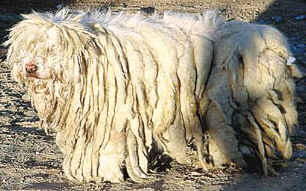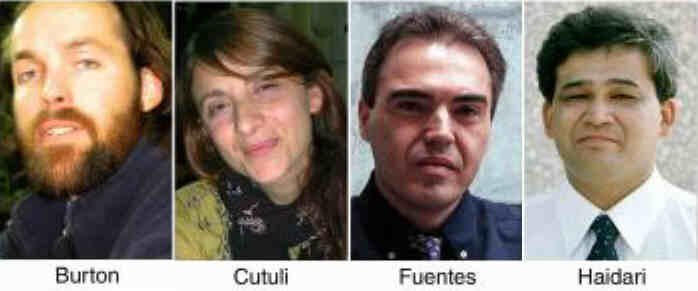^
Births
which occurred on a 19 November:
 1997
Alexis, Nathan, Natalie, Brandon, Joel, Kenny,
and Kelsey McCaughey,septuplets born to Bobbi and Kenny McCaughey,
in Des Moines, Iowa, the first time septuplets survived. On 10 May
2001, the mother would start their
weekly online journal.(written on 26 April) [photo: the septuplets
with their mother and older sister, Mikayla, born 3 January 1996 >] 1997
Alexis, Nathan, Natalie, Brandon, Joel, Kenny,
and Kelsey McCaughey,septuplets born to Bobbi and Kenny McCaughey,
in Des Moines, Iowa, the first time septuplets survived. On 10 May
2001, the mother would start their
weekly online journal.(written on 26 April) [photo: the septuplets
with their mother and older sister, Mikayla, born 3 January 1996 >]
In April 2001, this is the report on
the health of the seven toddlers:
Alexis
was diagnosed with hypotonic quadriplegia, which causes muscular weakness
in all four limbs. Nathan has spastic diplegia, a condition that causes
spasms in the legs. Alexis and Natalie had feeding problems (severe
reflux) when they were younger, which often required tube feedings
from a pump that would drip a high-calorie liquid directly into their
stomachs. Brandon, Joel, Kelsey, Kenny, and Natalie are thriving and
healthy.
And more information:
The septuplets were hospitalized for
several weeks after their birth at Blank Children's Hospital in Des
Moines. The last child released from the hospital was Alexis, who
came home March 12, 1998. Bobbi pumped breast milk for all seven babies
until they were three months old. The family now consumes four to
five gallons of milk each week. Today the septuplets are in various
stages of potty training. Kelsey is finished but still wears pull-up
diapers at night. Bobbi thinks it could take several months to toilet
train all seven children. By comparison, Mikayla was potty trained
in less than four days! The septuplets use about 150-170 diapers each
week. All the girls wear identical outfits, as do the boys. The children's
shoe sizes, however, differ. Joel wears a larger size than the others.
Carter's, a children's clothing manufacturer, is providing clothing
for the McCaughey seven until the kids turn five years old. In November
1998, the McCaugheys moved from their compact 800-square-foot home
into a spacious new house with five bedrooms and five baths, built
for them and donated by the state of Iowa. For the first eight months
of the children's lives, Bobbi and Kenny had child care 22 out of
the 24 hours in the day. 70 volunteers (usually 8-9 each day) helped
the family with feeding, changing and caring for the septuplets until
they began to sleep through the night. Today the family has child
care only one to two days a week. Bobbi and Kenny have a regular "date
night" every Friday. The septuplets' favorite meal is breakfast.
About the mom, Bobbi:
Born
July 18, 1968 in Alberta, Canada Currently lives in Carlisle, Iowa
(population: 3500) A devout Christian and preacher's daughter (her
dad, Bob Hepworth, is a Baptist minister) Met Kenny on a blind date
arranged by her sister, Barbara, and brother in-law, Neil Married
Kenny on December 5, 1983 Bobbi is a professional seamstress, but
she once considered a career as a nurse or secretary. |
1952 Los Poemas completos de Dylan Thomas se publican.
1950 Ángel Fieramente Humano, libro de poemas
de Blas de Otero, se publica.
1942 Calvin Klein,
fashion designer
1938 Ted Turner broadcasting mogul/owns
(Atlanta Braves)/won America's Cup 1938 - Ted Turner (cable TV mogul: CNN,
TBS, TNT, The Cartoon Network; owner: Atlanta Braves; TIME magazine's Man
of the Year [1991]; married to actress, Jane Fonda)
1935
John F Welch Jr Salem MA, CEO (GE)
1917 Indira
Nehru Gandhi Allahabad India, (Prime Minister of India [1966-1977
and 1980-84]: assassinated [1984]) — Indira Gandhi, fille du pandit
Nehru, est née le 19 novembre 1917 à Allahabad. Premier ministre de l'Union
indienne, elle a été assassinée en 1984.
1915 Earl Wilburg
Sutherland, investigador estadounidense, Premio Nobel de Medicina
y Fisiología en 1971.
1912 George Emil Palade, biólogo
estadounidense, Premio Nobel de Medicina en 1974.
1908 Alfredo
Pareja Diezcanseco, escritor e historiador ecuatoriano. [¿No
sería más correcto “Cincoparejas Diezcanessecos”?]
^
1907 Jack Schaefer, the author
of Shane, one of the most popular westerns of all time,
in Cleveland, Ohio.
During the
first half of his life, Schaefer was a successful journalist, but
Shane was his first attempt at a novel. Published in 1949, when Schaefer
was 42, this simple but powerful tale of a high-plains drifter who
comes to the rescue of Wyoming homesteaders was a popular and critical
success, as was the 1953-film adaptation starring Alan Ladd. Buoyed
by this overwhelming reception, Schaefer became a full-time writer
and wrote several other memorable novels, short-story collections,
and historical books.
Shane,
though, has remained Schaefer's most popular and influential work,
in part due to the wider audience the film version captured for the
story. Like the protagonist of Owen Wister's 1902 novel, The Virginian,
Schaefer's Shane helped construct the popular image of the western
cowboy as an all-natural nobleman on horseback. Shane was the American
version of the valorous European knight, who roams a lawless kingdom
righting wrongs and striking down the evil oppressors of the common
people.
In Shane, Schaefer
deliberately left the hero's past obscure, only hinting that he had
once been a skilled gunman who wished to leave his violent past behind.
Loosely based on the true story of the late-nineteenth-century Wyoming
range wars between homesteaders and cattle barons, Schaefer set his
novel in a high western valley. One of the most elegant representations
of the powerful Western novel, Shane inspired legions of imitators
and helped make the genre one of the most popular of the second half
of the twentieth century. |
1901 Bari,
mathematician.
1900 Lavrentev,
mathematician.
1900 Anna Seghers, escritora alemana.
^
1899 Allen Tate, in Winchester, Kentucky, poet and
critic.
Tate attended Vanderbilt
University, where he helped found a well-regarded poetry magazine,
The Fugitive, along with poet John Crowe Ransom. The Fugitives,
as the poets called themselves, advocated Southern regionalism and
a return to agrarian values.
After 1934, Tate taught at Princeton University, University of Minnesota,
and other schools while writing his own poetry. In the mid-1940s,
he edited a literary journal, The Sewanee Review. Tate converted
to Catholicism in 1950, and several of his best-known poems, including
The Buried Lake (1953), are devotional poems. Tate was an
influential proponent of the New Criticism, as set forth by Ransom
in his 1941 book of that title. Previously, literary criticism had
tended to focus on the writer's biography and life; New Critics treated
a poem or book as complete in itself, to be analyzed objectively,
through close reading, without reference to the author's background.
New Criticism's emphasis on close reading underlies the way literature
is taught in most high schools and colleges today. Tate died in Nashville
in 1979. |
1894 Heinz
Hopf, mathematician.
1888 José Raúl
Capablanca, Cuba, world chess champion (1921-27)
1875
Hiram Bingham, explorer who discovered the Inca city of Machu Picchu
1867 Bernard Johan de Hoog, Dutch artist who died
in 1943.
1862 William (Billy) Sunday, US revivalist.
Orphaned during the Civil War, Sunday became a major league baseball player
1883-91, then turned to evangelism in 1893, speaking to an estimated total
audience of 100 million before his death in 1935, yet his influence was
superficial.
1831 James Abram Garfield, in Orange,
Ohio, 20th US President (04 Mar 1881 – 19 Sep 1881) 1st left-handed
US president; (died assassinated)
1821 David Joseph Bles,
Dutch artist who died on 03 November 1899.
1819 El Museo del
Prado en Madrid, bajo la dirección del marqués de Santa Cruz y
del pintor Vicente López, se inaugura.
1805 Ferdinand de
Lesseps France, diplomat (built Suez Canal) — Ferdinand de
Lesseps, ingeniero y diplomático francés.
^
1805 Ferdinand-Marie de Lesseps,
French diplomat famous for building the Suez Canal across the Isthmus
of Suez (1859–1869) in Egypt. He died on 07 December 1894.
Lesseps was from a family long distinguished
in government service. Appointed assistant vice-consul at Lisbon in
1825, he was sent in 1828 to Tunis and in 1832 to Alexandria, where
he studied a proposal (by one of Napoleon's engineers) for a Suez
Canal. At Alexandria the survey report of J.-M. Le Père, one
of Napoleon's chief engineers, on the Isthmus of Suez, and his friendship
with Muhammad 'Ali, the Turkish viceroy of Egypt, and his son, Sa'id
Pasha, led Lesseps to hope that he might one day finish the canal
that Le Père had begun. For the time, however, he could not
pursue his plans. From 1833 to 1837, Lesseps was consul at Cairo,
where he gained distinction in combating an outbreak of plague. Two
years later he was transferred to Rotterdam. Subsequently he served
at Málaga and at Barcelona, where he was promoted to consul
general. From 1848 to 1849, after the proclamation of the Second Republic,
he was minister of France at Madrid. In May 1849 he sent a mission
to Rome, from where Pope Pius IX had fled and where Giuseppe Mazzini
had proclaimed the republic. This mission was ambiguous: it was a
question of “placing a limit on the pretensions of Austria .
. . of ending by arbitration . . . the differences which divided .
. . the peninsula. . . .” Lesseps tried to reconcile the irreconcilables:
the papacy and the republic. But at the end of May, when the French
Legislative Assembly, conservative by nature, followed the Constituent
Assembly, which held republican views, he was recalled, handed over
to the Council of State, and censured. French troops reestablished
pontifical power in Rome. The diplomatic career of Lesseps was shattered.
But in 1854, an invitation from Sa'id Pasha [1822 – 18 Jan 1863],
newly appointed viceroy, or khedive, of Egypt, revived his ambitions.
On 30 November 1854, Sa'id Pasha signed the first act of concession
authorizing Lesseps to pierce the isthmus of the Suez.
A first scheme, directed by Lesseps, was immediately drawn up by the
surveyors Linant Bey (L.-M. Linant de Bellefonds) and Mougel Bey (E.
Mougel) providing for direct communication between the Mediterranean
and Red Sea, and, after being slightly modified, it was adopted by
an international commission of engineers in 1856. Encouraged by this
approval, Lesseps allowed no obstacles to retard the work, and he
succeeded in rousing the French people to subscribe more than half
the capital needed to form the company, which was organized in 1858.
The first blow of the pickax was given by Lesseps at Port Said on
25 April 1859; and 10 years later, on
17 November 1869, the Suez Canal was officially inaugurated by
the empress Eugénie, who had been invited by the host of the
celebrations, the khedive (viceroy), Isma?il Pasha. In 1875 the British
government, on the initiative of the prime minister, Benjamin Disraeli,
purchased the khedive Isma?il's Suez Canal shares and became the largest
shareholder. Lesseps cooperated loyally with the British (in spite
of the fact that they had earlier tried to block the building of the
canal because of their suspicions of the French) and facilitated the
transfer of ownership. Though he usually tried to keep out of politics,
Lesseps stood as a Bonapartist candidate for a seat in the Chamber
of Deputies at Marseille in 1869 but was defeated by Léon Gambetta,
later one of the founders of the Third Republic.
In 1879, when the International Congress of Geographical Sciences
met in Paris and voted in favor of the construction of a Panama canal,
the 74-year-old Lesseps undertook to carry out the project. His despotic
temper and stubbornness, however, made him fail to appreciate the
difficulties of the task: at first he thought that it would be possible
to pierce a canal without locks, even though the route was barred
by the Culebra cut and by the torrential Chagres River. The task proved
to be beyond the capacities of a private company, so that eventually,
in 1889, the company that Lesseps had formed had to liquidate. After
an official inquiry in 1892, the French government instituted the
prosecution of the company's administrators, and in February 1893
Lesseps and his son Charles [1849–1923] were sentenced to five
years' imprisonment. Only Charles, however, was imprisoned, and in
June an appeals court reversed the decision. On the other hand, the
fact that members of the government and parliamentarians were accused
of having accepted bribes from the company made the Panama scandal
a political affair as well as a financial one, with important repercussions
in the history of the Third French Republic.
Lesseps was a member of the French Academy, of the Academy of Sciences,
and of numerous scientific societies. He was also decorated with the
grand cross of the Légion d'Honneur and the Star of India and
received the freedom of the City of London. His great gifts, unselfishness,
and social charm made him everywhere respected, and the scandal that
clouded his last years has done nothing to tarnish his reputation. |
1794 James Stark, British artist who died on 24 March 1859.
— more with links
to two images.
1780 José Cuero y Caicedo, religioso
franciscano colombiano.
1772 Vicente López Portaña,
pintor español. Murió en 1850. — MORE
ON LOPEZ AT ART “4” NOVEMBER
with links to images.
1770 Albert Bertel Thorvaldsen
Copenhagen Denmark, sculptor (Dying Lion)
1696 Louis Tocqué
(or Toucquet), French portrait painter and engraver who died on 10 February
1772. — MORE
ON TOCQUÉ AT ART “4” NOVEMBER
with links to images.
1617 Eustache Le Sueur
(or Lesyeur), French painter who died on 30 April 1655. — MORE
ON LE SUEUR AT ART “4” NOVEMBER
with links to images.
1607 Erasmus Quellin II, Flemish
painter who died on 07 November 1678. — MORE
ON QUELLIN AT ART “4” NOVEMBER
with links to images.
1600 Charles I king of England
(from the death of his father James I [19 Jun 1566 – 27 Mar 1625])
who would be executed by Parliament on 30 January 1649. A patron of the
arts, he brought both Van Dyck [22 Mar 1599 – 09 Dec 1641] and Rubens
[28 Jun 1577 – 30 May 1640] to England. — Carlos I, Rey de Inglaterra,
Escocia e Irlanda. — Van Dyck painted the flattering portraits Charles
I: King of England at the Hunt (1635; 800x603pix, 139kb) _ Charles
I on Horseback (1635, 365x289cm; 900x682pix, 128kb) _ Equestrian
Portrait of Charles I, King of England (1640, 123x85cm; 914x637pix,
87kb) _ Charles
I in Three Positions (1636) _ Charles
I of England and Henrietta of France
|




